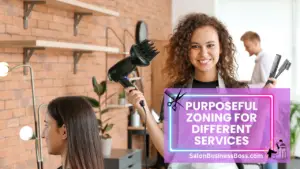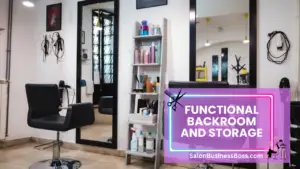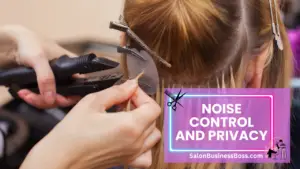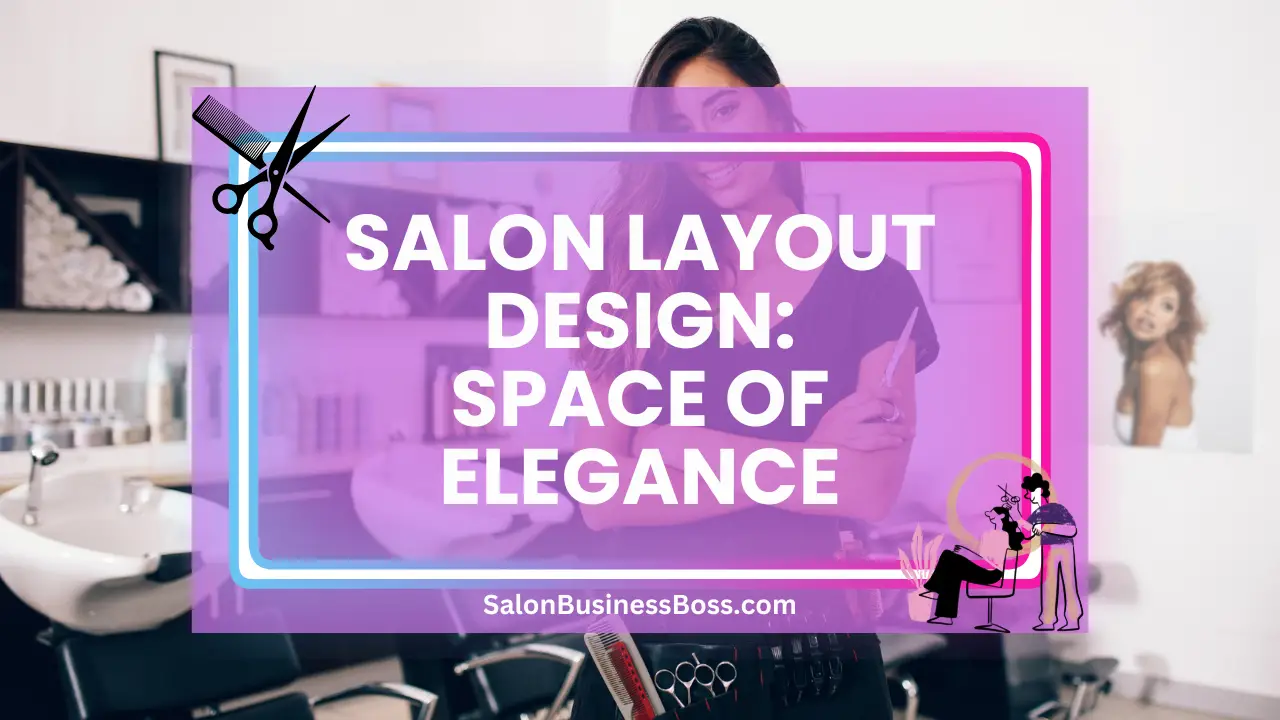The layout design of a salon plays a crucial role in shaping the overall experience for both clients and staff. A well-planned salon layout not only enhances the aesthetic appeal but also ensures efficient workflows, comfortable interactions, and a seamless customer journey.
A salon layout design includes purposeful zoning for different services, creating a welcoming reception area, optimizing ergonomic styling stations, and utilizing natural light. Smart use of colors, noise control, and compliance ensure a serene atmosphere. Flexibility allows for future growth and evolving trends. A thoughtfully planned salon layout enhances customer experience and business success.
1. Purposeful Zoning for Different Services

In salon layout design, purposeful zoning for different services is a foundational element that significantly impacts the overall customer experience and operational efficiency. By strategically dividing the salon into distinct zones for various services like haircuts, hair coloring, nail treatments, skincare, and spa services, a seamless flow is created within the salon space. Each designated zone should be thoughtfully equipped with the necessary tools and equipment to facilitate smooth and uninterrupted service delivery.
This zoning approach not only optimizes the workflow for salon staff but also enhances the client experience. When clients enter the salon, they are directed to their specific service area, minimizing confusion and helping them feel more at ease. A well-organized layout instills confidence in clients, knowing that the salon is well-prepared to cater to their specific needs.
Purposeful zoning allows for efficient resource allocation, ensuring that each service area is equipped with the right tools and products. It streamlines the movement of both staff and clients, reducing wait times and promoting a sense of professionalism.
By paying attention to purposeful zoning, salon owners can create a harmonious and organized environment that fosters customer loyalty and word-of-mouth referrals. Clients are more likely to return when they experience a seamless and comfortable journey through the salon’s well-defined zones, enhancing overall customer satisfaction and loyalty.
Read more about: Hair Salon Floor Plan Layout: Designing Your Dream Salon
2. Reception Area: The First Impression
The reception area of a salon holds immense significance as it serves as the first point of contact between the business and its clients. It is the space where clients form their initial impressions, making it essential to design this area with care and attention to detail.
To create a memorable first impression, the reception area should exude a welcoming ambiance that aligns with the salon’s brand identity. The choice of decor, color schemes, and furniture should reflect the salon’s style and values. Comfortable seating arrangements are essential to ensure that clients feel relaxed while waiting for their appointments.
An engaging display of products or salon portfolios in the reception area can pique the interest of clients and serve as an excellent opportunity for showcasing the salon’s services and retail offerings. It can also encourage clients to inquire about additional services or products, potentially boosting revenue.
Equally important is having a well-trained and friendly receptionist who can warmly greet clients, address their inquiries, and manage appointments efficiently. A courteous and attentive receptionist leaves a positive impression on clients, making them feel valued and attended to from the moment they step inside the salon.
3. Ergonomic Styling Stations
When designing a salon layout, prioritizing ergonomic styling stations is essential for the well-being and productivity of hairdressers and stylists. These professionals often spend long hours standing and working on clients, which can lead to physical strain and fatigue if the styling stations are not ergonomically optimized.
To address these challenges, salon owners should invest in comfortable and adjustable seating for the stylists. Ergonomic chairs with proper back and lumbar support promote good posture and reduce the risk of back pain or discomfort. Height-adjustable chairs allow stylists to position themselves at the ideal height for each client, minimizing strain on their arms and shoulders during styling procedures.
Adequate lighting is another crucial aspect of ergonomic styling stations. Well-placed lighting, such as LED lights positioned at the right angles, ensures that stylists have clear visibility while working on clients’ hair. Proper lighting not only enhances the quality of service but also reduces eye strain and fatigue.
Easy access to tools and supplies is equally important. Stylists should have their essential tools within arm’s reach, avoiding unnecessary bending or reaching that can strain their muscles and joints. Customizable stations that cater to individual stylist preferences and working styles empower the staff to create a personalized and supportive workspace.
By prioritizing ergonomic styling stations, salon owners show a commitment to the health and well-being of their staff. Creating a comfortable and efficient work environment enables stylists to focus on their craft and deliver exceptional service to clients, ultimately leading to higher job satisfaction and staff retention.
4. Optimizing Waiting Areas
The waiting area is a crucial space in a salon, as it sets the tone for the overall client experience. An optimized waiting area can help create a positive and relaxing atmosphere for clients, ensuring they feel comfortable and valued from the moment they enter the salon.
Comfort is key when designing the waiting area. Plush and well-padded seating provides a cozy and inviting environment for clients to relax while they wait for their services. Incorporating different seating options, such as sofas, armchairs, and ottomans, caters to varying client preferences.
To keep clients engaged and entertained, offering reading materials such as magazines, fashion books, or tablets with digital content can be a great idea. This not only helps pass the time but also showcases the salon’s dedication to providing a pleasant and enjoyable experience.
Providing refreshments is another thoughtful touch. Offering beverages like water, tea, or coffee creates a hospitable environment, making clients feel valued and cared for. Moreover, the waiting area is an excellent opportunity to display retail products or promotional offers, encouraging clients to browse and potentially make additional purchases.
By optimizing the waiting area, salon owners can enhance customer satisfaction and create a positive first impression. A well-designed waiting area demonstrates the salon’s commitment to customer comfort and enjoyment, setting the stage for a delightful salon experience overall.
5. Functional Backroom and Storage

The backroom and storage area in a salon are often overlooked, but they play a critical role in maintaining an organized and clutter-free workspace. Efficient storage solutions are vital to ensure that supplies, tools, and equipment are easily accessible when needed, contributing to smoother salon operations.
To make the most of the available space, utilize vertical storage with shelving units and cabinets. Vertical storage not only maximizes space efficiency but also helps keep items well-organized and easily identifiable. Grouping similar items together and using labeled containers can further streamline the retrieval process.
Having a designated break area for staff is equally important. A comfortable and inviting space where staff can take breaks and unwind contributes to their job satisfaction and overall well-being. Providing amenities such as a refrigerator, microwave, and seating area allows staff to relax during their downtime, fostering a positive work environment.
Creating dedicated storage space for staff to store their personal belongings demonstrates consideration for their needs. Lockers or designated shelves offer a secure and organized solution, promoting staff satisfaction and a sense of belonging within the salon.
By prioritizing functional backroom and storage solutions, salon owners can maintain a clean and efficient workspace, making it easier for staff to focus on delivering exceptional services to clients. A well-organized backroom not only enhances staff productivity but also reflects a professional image to clients, contributing to their overall salon experience.
Read more about: Salon Savvy: Marketing Strategies for Hair Salons
6. Utilizing Natural Light and Proper Lighting
In salon layout design, harnessing the power of natural light can significantly enhance the ambiance and overall appeal of the space. If possible, orient the salon layout to maximize natural light exposure in waiting areas and styling stations. Natural light not only creates a warm and welcoming atmosphere but also positively impacts the mood and well-being of clients and staff.
For areas with limited access to natural light, investing in proper artificial lighting is essential. Adequate and well-placed artificial lighting ensures that all areas of the salon have sufficient illumination for safe and efficient operations. Avoiding harsh or overly dim lighting is crucial, as it can negatively affect color perception and the quality of services provided.
In particular, paying attention to lighting in hair coloring zones is critical for accurate results. Color-corrected lighting ensures that stylists can see the true colors of the hair, enabling them to make precise color decisions and achieve the desired outcomes.
Well-lit mirrors are essential for both stylists and clients. Properly illuminated mirrors allow stylists to see their work clearly and ensure attention to detail, while clients can view their hair or makeup with confidence.
7. Smart Use of Colors and Décor
The strategic use of colors and décor plays a vital role in shaping the atmosphere and experience within a salon. When designing the salon layout, it’s essential to consider the psychological impact of colors on clients’ emotions and perceptions. Calming and soothing colors, such as soft pastels or earth tones, can create a sense of relaxation and tranquility, making clients feel at ease during their visit.
To maintain a cohesive design theme, the salon’s décor should reflect its branding and overall identity. This can be achieved through careful selection of furniture, fixtures, and decorative elements that align with the salon’s style and vision. Harmonizing the colors and textures in the space fosters a sense of unity and professionalism.
Artwork and accent walls can add character to the salon without overpowering the space. Consider displaying tasteful art pieces or incorporating accent walls with a complementary color to create visual interest and a focal point. However, moderation is key, as too much decoration can lead to a cluttered or overwhelming environment.
The goal is to create a harmonious and inviting ambiance that appeals to the senses, leaving a positive and lasting impression on clients. A well-thought-out use of colors and décor in the salon layout enhances the overall customer experience, contributing to client satisfaction and loyalty.
8. Accessibility and Compliance
Inclusive salon design is paramount to ensure that all clients, regardless of their mobility challenges, can access and enjoy the salon’s services comfortably. A salon layout should adhere to relevant accessibility guidelines and regulations, making it welcoming and convenient for everyone.
Implementing features like wheelchair ramps and wide entrances allows clients with mobility aids to enter the salon easily. Thoughtful design considerations should also extend to the restroom facilities, ensuring they are accessible and equipped with handrails for added safety.
Compliance with local building codes and safety regulations is essential to create a secure environment for both clients and staff. Ensuring proper fire exits, emergency lighting, and safety protocols guarantees that the salon operates within legal and ethical parameters.
By prioritizing accessibility and compliance, salon owners demonstrate their commitment to inclusivity and client welfare. A salon that embraces accessibility not only broadens its potential client base but also fosters a sense of community and goodwill among clients and staff alike. A safe and welcoming environment ensures that every individual feels valued and respected, contributing to a positive and enjoyable salon experience for all.
9. Noise Control and Privacy

Creating a serene and peaceful atmosphere is essential to ensure that clients can fully relax and enjoy their salon experience. Noise control measures are instrumental in minimizing distractions and creating a calming environment. Installing acoustic panels on walls and ceilings helps absorb sound, reducing background noise and echoes that can disrupt the tranquility of the space. Additionally, using soundproof partitions between stations and treatment areas enhances privacy and reduces noise leakage.
Privacy is another critical aspect that contributes to client comfort during salon services. Clients appreciate having a sense of personal space and confidentiality while receiving treatments. Ensure that each station or treatment area is appropriately separated to provide clients with a level of seclusion. For example, using dividers or curtains between styling chairs and incorporating private rooms for specific services like massages or facials can enhance the feeling of privacy.
By prioritizing noise control and privacy in the salon layout, owners create an environment where clients can unwind, recharge, and indulge in self-care fully. The tranquil ambiance not only promotes a positive experience but also encourages clients to return and recommend the salon to others, ultimately fostering client loyalty and business growth.
Read more about: Designing Beauty Salon Floor Plans for Optimal Customer Experience
10. Flexibility and Future Growth
Designing the salon layout with flexibility in mind is a strategic approach that allows the business to adapt to changing trends and client preferences. A flexible space can easily accommodate modifications, making it easier to stay relevant and competitive in the fast-paced beauty industry.
Investing in movable furniture and modular design elements provides the versatility needed for rearranging the salon layout as needed. Whether it’s rearranging styling stations, creating pop-up retail areas, or hosting special events, the salon can quickly adjust to various purposes.
Leaving room for future growth is equally important, especially for salons looking to expand their services or add more staff in the future. Consider designating areas that can be repurposed as the business evolves, such as creating an extra station or treatment room that can be easily transformed to meet new demands.
A flexible and adaptable salon layout demonstrates a proactive approach to business development. The ability to respond swiftly to market changes and customer demands enhances the salon’s reputation as a forward-thinking and customer-centric establishment. By fostering flexibility and future growth, salon owners position their businesses for long-term success and prosperity in the ever-evolving beauty industry.
Conclusion
A thoughtfully designed salon layout can be a powerful tool in elevating the customer experience and driving business success. By purposefully zoning different service areas, creating a welcoming reception space, optimizing styling stations and waiting areas, ensuring proper lighting and storage, and incorporating accessible and compliant design elements, salon owners can create an inviting and efficient space that both clients and staff will appreciate. The combination of comfort, functionality, and aesthetics will ultimately contribute to the salon’s reputation and success in the competitive beauty industry.
Frequently Asked Questions

1. What role does staff feedback play in the design process?
Gathering staff feedback is essential to understand their needs and preferences, ensuring a supportive work environment that boosts their productivity and job satisfaction.
2. How can I create a unique and memorable salon design?
Consider incorporating unique design elements, customized fixtures, and personalized touches that align with the salon’s identity to create a memorable experience for clients.
3. Can I update my salon layout in the future without major renovations?
Yes, planning for flexibility and using modular elements allows for easy updates and reconfigurations without the need for significant renovations or disruptions to salon operations.
To learn more on how to start you own salon checkout my startup documents here.
Please note that the contents of this blog are for informational and entertainment purposes only and should not be construed as legal advice. Any action taken based on the information provided in this blog is solely at your own risk. Additionally, all images used in this blog are generated under the CC0 license of Creative Commons, which means they are free to use for any purpose without attribution.

About the author. Entrepreneur and Salon Business Fan.
Hi! I am Shawn and I am a happy individual who happens to be an entrepreneur. I have owned several types of businesses in my life from a coffee shop to an import and export business to an online review business plus a few more and now I create online salon business resources for those interested in starting new ventures. It’s demanding work but I love it. I do it for those passionate about their business and their goals. That’s why when I meet a salon business owner, I see myself. I know how hard the struggle is to retain clients, find good employees and keep the business growing all while trying to stay competitive.
That’s why I created Salon Business Boss: I want to help salon business owners like you build a thriving business that brings you endless joy and supports your ideal lifestyle.

